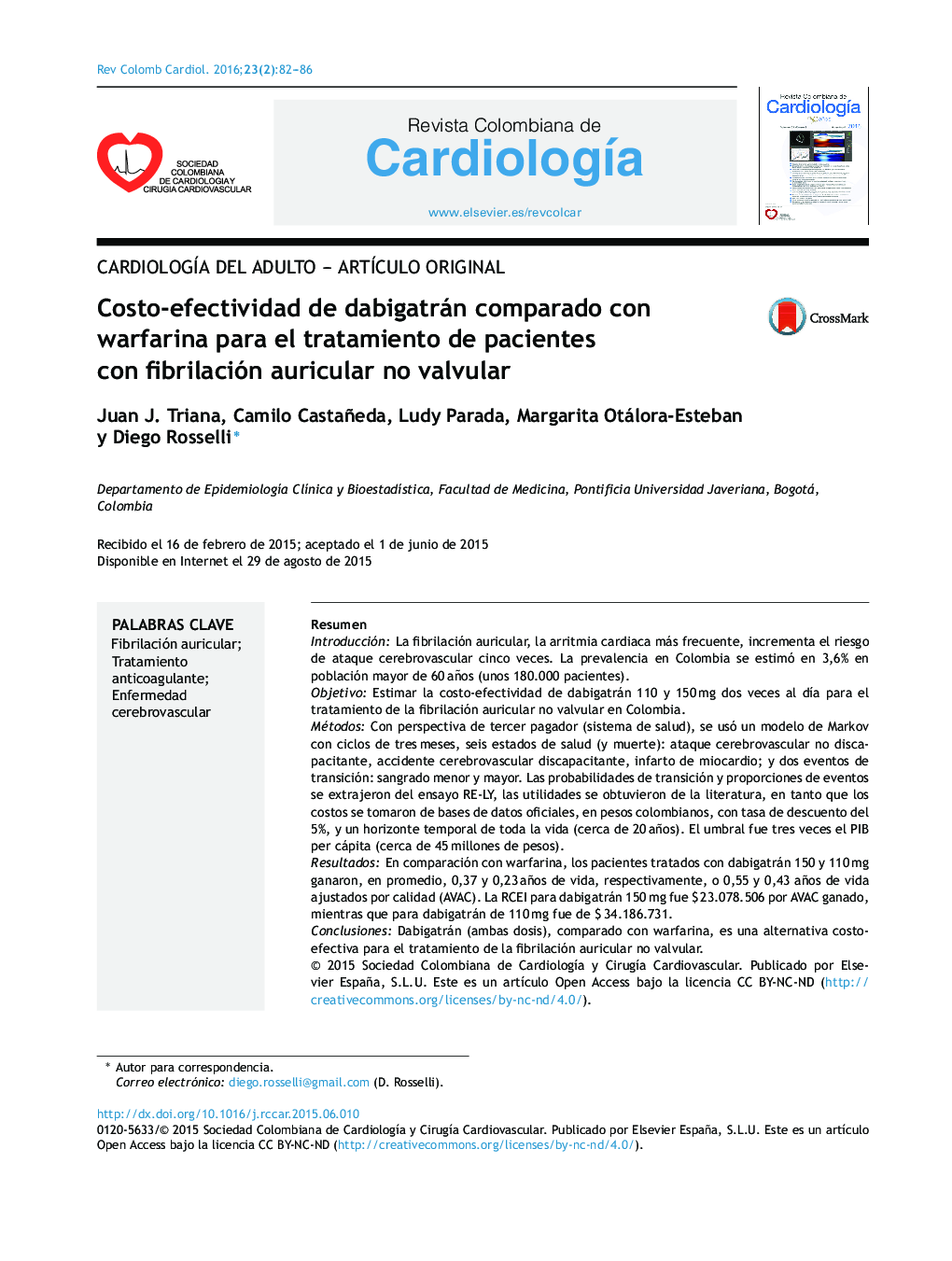| کد مقاله | کد نشریه | سال انتشار | مقاله انگلیسی | نسخه تمام متن |
|---|---|---|---|---|
| 3012127 | 1181790 | 2016 | 5 صفحه PDF | دانلود رایگان |

ResumenIntroducciónLa fibrilación auricular, la arritmia cardiaca más frecuente, incrementa el riesgo de ataque cerebrovascular cinco veces. La prevalencia en Colombia se estimó en 3,6% en población mayor de 60 años (unos 180.000 pacientes).ObjetivoEstimar la costo-efectividad de dabigatrán 110 y 150 mg dos veces al día para el tratamiento de la fibrilación auricular no valvular en Colombia.MétodosCon perspectiva de tercer pagador (sistema de salud), se usó un modelo de Markov con ciclos de tres meses, seis estados de salud (y muerte): ataque cerebrovascular no discapacitante, accidente cerebrovascular discapacitante, infarto de miocardio; y dos eventos de transición: sangrado menor y mayor. Las probabilidades de transición y proporciones de eventos se extrajeron del ensayo RE-LY, las utilidades se obtuvieron de la literatura, en tanto que los costos se tomaron de bases de datos oficiales, en pesos colombianos, con tasa de descuento del 5%, y un horizonte temporal de toda la vida (cerca de 20 años). El umbral fue tres veces el PIB per cápita (cerca de 45 millones de pesos).ResultadosEn comparación con warfarina, los pacientes tratados con dabigatrán 150 y 110 mg ganaron, en promedio, 0,37 y 0,23 años de vida, respectivamente, o 0,55 y 0,43 años de vida ajustados por calidad (AVAC). La RCEI para dabigatrán 150 mg fue $ 23.078.506 por AVAC ganado, mientras que para dabigatrán de 110 mg fue de $ 34.186.731.ConclusionesDabigatrán (ambas dosis), comparado con warfarina, es una alternativa costo-efectiva para el tratamiento de la fibrilación auricular no valvular.
IntroductionAtrial fibrillation (AF), the most common cardiac rhythm disorder, increases the risk of stroke risk by 5 fold. AF prevalence in Colombia has been estimated in 3.6% in population age 60 or over (some 180 000 patients).ObjectiveThe aim of this study was to estimate cost-effectiveness of dabigatran 110 and 150 mg BID compared with warfarin as a therapy for non valvular AF in Colombian population.MethodsFrom a third-party payer perspective (Colombian health system) we used a three-month cycle Markov model with 6 health states (and death): non-disabling stroke, disabling stroke, myocardial infarction and pulmonary embolism; two additional events were minor and mayor bleeding. Transition probabilities and proportion of events were extracted from the RELY trial; utilities were derived from the literature. Costs for medications and procedures were obtained from official government databases, all costs were in 2014 Colombian pesos (1 USD = 2.000 COP). Annual discount rate was 5% and we used a life time horizon (close to 20 years, on average). Cost-effectiveness threshold was 3 times per capita GDP (around USD 22,500).ResultsCompared with warfarin, patients treated with dabigatran 150 and 110 mg gained, on average 0.37 and 0.23 life-years respectively, or 0.55 and 0.43 QALYs. The ICER for dabigatran 150 mg was USD 11,537 per QALY, and for dabigatran 110 mg was 17,090 per QALY gained.ConclusionsDabigatran 150 and 110 mg, compared with warfarin —the standard therapy— are cost-effective therapies for ambulatory treatment of patients with non valvular AF.
Journal: Revista Colombiana de Cardiología - Volume 23, Issue 2, March–April 2016, Pages 82–86